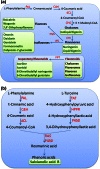Recent advances in biosynthesis of bioactive compounds in traditional Chinese medicinal plants
- PMID: 26844006
- PMCID: PMC4722072
- DOI: 10.1007/s11434-015-0929-2
Recent advances in biosynthesis of bioactive compounds in traditional Chinese medicinal plants
Abstract
Plants synthesize and accumulate large amount of specialized (or secondary) metabolites also known as natural products, which provide a rich source for modern pharmacy. In China, plants have been used in traditional medicine for thousands of years. Recent development of molecular biology, genomics and functional genomics as well as high-throughput analytical chemical technologies has greatly promoted the research on medicinal plants. In this article, we review recent advances in the elucidation of biosynthesis of specialized metabolites in medicinal plants, including phenylpropanoids, terpenoids and alkaloids. These natural products may share a common upstream pathway to form a limited numbers of common precursors, but are characteristic in distinct modifications leading to highly variable structures. Although this review is focused on traditional Chinese medicine, other plants with a great medicinal interest or potential are also discussed. Understanding of their biosynthesis processes is critical for producing these highly value molecules at large scale and low cost in microbes and will benefit to not only human health but also plant resource conservation.
Keywords: Alkaloid; Biosynthesis; Medicinal plant; Phenylpropanoid; Terpenoid.
Figures


Similar articles
-
Integrated omics analysis of specialized metabolism in medicinal plants.Plant J. 2017 May;90(4):764-787. doi: 10.1111/tpj.13485. Epub 2017 Mar 30. Plant J. 2017. PMID: 28109168
-
Strategies on biosynthesis and production of bioactive compounds in medicinal plants.Chin Herb Med. 2023 Aug 21;16(1):13-26. doi: 10.1016/j.chmed.2023.01.007. eCollection 2024 Jan. Chin Herb Med. 2023. PMID: 38375043 Free PMC article. Review.
-
[Development of Plant Metabolomics and Medicinal Plant Genomics].Yakugaku Zasshi. 2018;138(1):1-18. doi: 10.1248/yakushi.17-00193. Yakugaku Zasshi. 2018. PMID: 29311454 Review. Japanese.
-
[Ecological protection of medicinal woody plants].Ying Yong Sheng Tai Xue Bao. 2003 Sep;14(9):1561-4. Ying Yong Sheng Tai Xue Bao. 2003. PMID: 14733021 Review. Chinese.
-
Biosynthesis and biological functions of terpenoids in plants.Adv Biochem Eng Biotechnol. 2015;148:63-106. doi: 10.1007/10_2014_295. Adv Biochem Eng Biotechnol. 2015. PMID: 25583224 Review.
Cited by
-
Pseudotargeted metabolomics revealed the adaptive mechanism of Draba oreades Schrenk at high altitude.Front Plant Sci. 2022 Dec 8;13:1052640. doi: 10.3389/fpls.2022.1052640. eCollection 2022. Front Plant Sci. 2022. PMID: 36570906 Free PMC article.
-
Determination of Isoflavones in Radix puerariae from Different Origins by Ultra-High Performance Liquid Chromatography Based on Optimal Pretreatment Method.Foods. 2023 Feb 13;12(4):794. doi: 10.3390/foods12040794. Foods. 2023. PMID: 36832868 Free PMC article.
-
Bioprospecting Plant Growth Promoting Rhizobacteria for Enhancing the Biological Properties and Phytochemical Composition of Medicinally Important Crops.Molecules. 2022 Feb 19;27(4):1407. doi: 10.3390/molecules27041407. Molecules. 2022. PMID: 35209196 Free PMC article. Review.
-
Deciphering the effects of genotype and climatic factors on the performance, active ingredients and rhizosphere soil properties of Salvia miltiorrhiza.Front Plant Sci. 2023 Apr 20;14:1110860. doi: 10.3389/fpls.2023.1110860. eCollection 2023. Front Plant Sci. 2023. PMID: 37152152 Free PMC article.
-
Integrative metabolome and transcriptome analyses reveal the differences in flavonoid and terpenoid synthesis between Glycyrrhiza uralensis (licorice) leaves and roots.Food Sci Biotechnol. 2023 Nov 20;33(1):91-101. doi: 10.1007/s10068-023-01467-y. eCollection 2024 Jan. Food Sci Biotechnol. 2023. PMID: 38186628 Free PMC article.
References
-
- Harvey AL, Edrada-Ebel R, Quinn RJ. The re-emergence of natural products for drug discovery in the genomics era. Nat Rev Drug Discov. 2015;14:111–129. - PubMed
-
- Qiu J. Traditional medicine: a culture in the balance. Nature. 2007;448:126–128. - PubMed
-
- Chan E, Tan M, Xin J, et al. Interactions between traditional Chinese medicines and Western therapeutics. Curr Opin Drug Discov Dev. 2010;13:50–65. - PubMed
Publication types
LinkOut - more resources
Full Text Sources
Other Literature Sources

